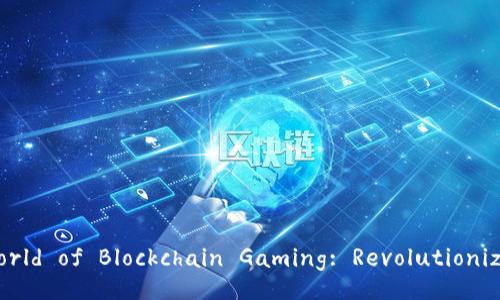Exploring the Exciting World of Blockchain Gaming: Revolutio
I. Introduction
- Definition and Overview of Blockchain Gaming
II. How Blockchain is Transforming the Gaming Industry
- Decentralized Gaming: Cutting Out Middlemen
- NFTs (Non-Fungible Tokens): Enhancing In-Game Assets
- Cryptocurrency Integration: Fostering Economic Growth
III. The Benefits of Blockchain Gaming
- Enhanced Security and Transparency
- Real Ownership of In-Game Assets
- User Empowerment and Engagement
IV. The Future of Blockchain Gaming
- Potential for Innovative Game Designs
- Growth Opportunities for Developers
- Widening the Gaming Industry’s Reach
V. Common Myths about Blockchain Gaming
- Inaccessible to Non-Tech Savvy Individuals
- Blockchain Gaming is Limited to Cryptocurrency
- Blockchain Gaming is a Fad
VI. Challenges and Potential Risks of Blockchain Gaming
- Adoption Issues
- Scalability and Performance Concerns
- Regulatory Obstacles
VII. Conclusion
- The Promising Future of Blockchain Gaming
Related Questions:
1. What is Blockchain Gaming and How Does it Work?
2. What is the Significance of Decentralization in Blockchain Gaming?
3. How do NFTs Change the Gaming Experience?
4. What are the Benefits and Downsides of Cryptocurrency Integration in Gaming?
5. What are the Future Prospects of Blockchain Gaming in the Gaming Industry?
6. How do Blockchain Gaming Myths and Myopia Affect the Perception of this Innovative Technology?
I. Introduction
Blockchain is the technology behind cryptocurrencies such as Bitcoin and Ethereum, but its potential far exceeds being just a digital currency. One innovative application of blockchain is in the gaming industry, which is rapidly adopting this revolutionary technology. Blockchain gaming offers unique value propositions such as enhanced security, true ownership of assets, and decentralization.
II. How Blockchain is Transforming the Gaming Industry
a. Decentralized Gaming: Cutting Out Middlemen
The blockchain is a decentralized technology that disintermediates transactions, resulting in a direct peer-to-peer transaction between parties. This has revolutionized the gaming industry by eliminating middlemen and intermediaries, enabling gamers to interact and transact with each other directly. This model has drastically reduced the costs associated with giving third parties a cut of revenue (e.g., app store fees) and has allowed gaming platforms to provide a more seamless and fair gaming experience for its users.
b. NFTs (Non-Fungible Tokens): Enhancing In-Game Assets
Blockchain gaming has unlocked the potential to make in-game assets more valuable and meaningful. Non-Fungible Tokens or NFTs are digital assets that are one-of-a-kind and have unique attributes. This enables gamers to own digital items that are uniquely theirs. These NFTs can represent anything from rare weapons to rare skins.
c. Cryptocurrency Integration: Fostering Economic Growth
The integration of cryptocurrency in Blockchain gaming has led to cross-industry price stability and growth. This also allows businesses to easily standardize payments without intermediaries and bank fees. This has revolutionized the gaming experience by reducing costs while increasing growth potential.
III. The Benefits of Blockchain Gaming
a. Enhanced Security and Transparency
Blockchain gaming provides enhanced security through smart contracts, which are enforceable via programming code. This helps protect gamers’ in-game assets from hackers and fraud. Additionally, blockchain provides transparency where gamers can easily access and validate all transaction history.
b. Real Ownership of In-Game Assets
In blockchain gaming, gamers have real ownership of their in-game assets. This means that gamers can sell, exchange, and even trade these assets without the need for middlemen or intermediaries. This has transformed the gaming industry by allowing gamers to have complete control over their gaming assets.
c. User Empowerment and Engagement
Blockchain gaming empowers gamers to be part of the game's development process. This is achieved through blockchain-based governance, where they can vote on implementation priorities, new features, and fixes. This has created a sense of ownership, where gamers feel their contribution is valued, increasing overall engagement.
IV. The Future of Blockchain Gaming
a. Potential for Innovative Game Designs
Blockchain Gaming has opened up possibilities for innovative game designs and features that can enhance the gaming experience. This includes fully autonomous gaming experiences, which can be achieved through smart contract integration. Also, blockchain technology enables gaming features such as NFTs that offer unique ownership, enabling gamers to possess exclusive items uniquely created for them.
b. Growth Opportunities for Developers
Blockchain gaming presents an opportunity for developers to create unique gaming experiences with minimal overhead costs and disruption to existing systems. Additionally, a growing network of blockchain gaming platforms is fostering growth and innovation in the industry. Some of these platforms include Ethereum and EOS.
c. Widening the Gaming Industry’s Reach
Blockchain gaming has the potential to expand its reach to players across the globe, regardless of whether they hold an active bank account or are in a developing country. This creates more opportunities for game adoption, especially for gamers in regions that are typically underrepresented.
V. Common Myths about Blockchain Gaming
a. Inaccessible to Non-Tech Savvy Individuals
There is a common misconception that blockchain gaming is only accessible to tech-savvy individuals. However, new platforms are making blockchain technology more accessible, allowing gamers of all levels to participate. Additionally, developers understand that user experience is a critical factor in adoption, including user-friendly interfaces.
b. Blockchain Gaming is Limited to Cryptocurrency
While cryptocurrency integration is a key feature of blockchain gaming, it is in no way limited to that. Blockchain gaming can also offer unique features such as true asset ownership, security and decentralization that are meaningful to gamers, regardless of the payment method.
c. Blockchain Gaming is a Fad
Contrary to popular belief, blockchain gaming is not a fad. The industry is expected to grow steadily over the next few years, with potential for more innovative applications and use cases. In addition, ongoing investments and enterprise partnerships between leading traditional tech and blockchain gaming industry players demonstrate a commitment to develop and advance the field.
VI. Challenges and Potential Risks of Blockchain Gaming
a. Adoption Issues
Adoption is a critical issue that blockchain gaming faces. Primarily, developers and investors must convince established gaming communities to adopt blockchain solutions to facilitate a seamless transition while incorporating all the benefits of blockchain technology.
b. Scalability and Performance Concerns
Developers must ensure that blockchain gaming platforms can scale to accommodate broader future use. Nonetheless, scalability constraints pose a significant challenge due to the large amount of computing power required. This may present cost and technical problems in the short term.
c. Regulatory Obstacles
Another risk of Blockchain gaming is the lack of regulatory oversight. Regulatory ambiguity may hinder growth since regulatory authorities have yet to make a clear statement regarding the blockchain gaming industry.
VII. Conclusion
Blockchain gaming is furiously evolving, with the potential to identify innovative solutions for longstanding gaming industry concerns. The underlying advantages of blockchain gaming are decentralization, transparency, and true ownership of digital assets. Therefore, blockchain gaming is poised to create a more efficient and transparent gaming ecosystem that benefits gamers, developers, and businesses.
Related Questions:
1. What is Blockchain Gaming and How Does it Work?
Blockchain gaming is a gaming environment that incorporates blockchain technology, a digital payment and financing system, and peer-to-peer networks. It relies on a digital currency and provides infrastructure for decentralized exchanges – all enabled by blockchain technology. The Blockchain gaming industry is a subsector of the broader digital gaming industry that uses digital tokens or virtual assets in a decentralized structure.
2. What is the Significance of Decentralization in Blockchain Gaming?
Decentralization is a significant feature of blockchain gaming that offers several benefits. This feature eliminates intermediaries, allowing gamers to transact with each other directly. This also eliminates additional transaction costs and reduces fraud and hacking possibilities. With blockchain technology, gamers can trust the platform, reducing the risk of losing their assets.
3. How do NFTs Change The Gaming Experience?
Non-Fungible Tokens (NFTs) are digital assets that represent ownership of unique, rare, or exclusive in-game items. NFTs provide an opportunity for gamers to own exclusive items and be part of something unique. NFTs can increase engagement and loyalty since gamers can easily access exclusive collections and trades.
4. What are the Benefits and Downsides of Cryptocurrency Integration in Gaming?
Benefits of cryptocurrency integration in gaming include hassle-free money transfers and access to an expanded international gaming market without concerns about fluctuation in exchange rates. Besides, Blockchain gaming has eliminated a requirement for centralized payment gateways, i.e., banks, to facilitate monetary transactions. The downside of cryptocurrency integration in gaming is the uncertainty of security and the need for a stable platform to carry out transactions.
5. What are the Future Prospects of Blockchain Gaming in the Gaming Industry?
The future prospects of blockchain gaming are vast. As the industry continues to grow, there will be more investment in innovation, development of new games, and more players will become more interested in blockchain gaming. Furthermore, blockchain’s potential for a future where decentralized gaming ecosystems will be dominant is endless.
6. How do Blockchain Gaming Myths and Myopia Affect the Perception of this Innovative Technology?
Blockchain gaming myths and myopia have created much of the skepticism surrounding the blockchain gaming industry. Some of the common misconceptions are that blockchain gaming is limited to finance or cryptocurrency, or that it is too technical for the average gamer. These myths have created a perception of inaccessibility, and it is critical to address these issues within the industry to promote adoption. By addressing these myths and misconceptions, developers can create user-friendly blockchain gaming platforms that cater to all gamers.






